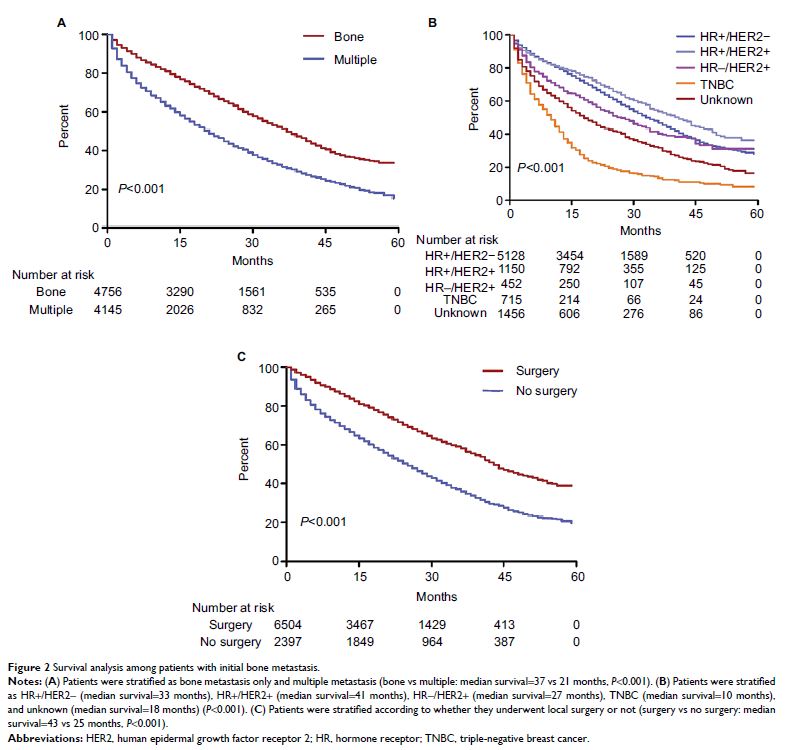108985
论文已发表
注册即可获取德孚的最新动态
IF 收录期刊
- 3.4 Breast Cancer (Dove Med Press)
- 3.2 Clin Epidemiol
- 2.6 Cancer Manag Res
- 2.9 Infect Drug Resist
- 3.7 Clin Interv Aging
- 5.1 Drug Des Dev Ther
- 3.1 Int J Chronic Obstr
- 6.6 Int J Nanomed
- 2.6 Int J Women's Health
- 2.9 Neuropsych Dis Treat
- 2.8 OncoTargets Ther
- 2.0 Patient Prefer Adher
- 2.2 Ther Clin Risk Manag
- 2.5 J Pain Res
- 3.0 Diabet Metab Synd Ob
- 3.2 Psychol Res Behav Ma
- 3.4 Nat Sci Sleep
- 1.8 Pharmgenomics Pers Med
- 2.0 Risk Manag Healthc Policy
- 4.1 J Inflamm Res
- 2.0 Int J Gen Med
- 3.4 J Hepatocell Carcinoma
- 3.0 J Asthma Allergy
- 2.2 Clin Cosmet Investig Dermatol
- 2.4 J Multidiscip Healthc

新发转移性乳腺癌的骨转移模式:一项以人群为基础的研究
Authors Xiong Z, Deng G, Huang X, Li X, Xie X, Wang J, Shuang Z, Wang X
Received 30 October 2017
Accepted for publication 9 December 2017
Published 9 February 2018 Volume 2018:10 Pages 287—295
DOI https://doi.org/10.2147/CMAR.S155524
Checked for plagiarism Yes
Review by Single-blind
Peer reviewers approved by Dr Justinn Cochran
Peer reviewer comments 2
Editor who approved publication: Dr Antonella D'Anneo
Purpose: Bone is one of the most common sites of breast cancer metastasis,
and population-based studies of patients with bone metastasis in initial
metastatic breast cancer (MBC) are lacking.
Materials and
methods: From 2010 to 2013, 245,707 breast
cancer patients and 8901 patients diagnosed with initial bone metastasis were
identified by Surveillance, Epidemiology, and End Results database of the
National Cancer Institute. Multivariate logistic and Cox regression were used
to identify predictive factors for the presence of bone metastasis and
prognosis factors. Kaplan–Meier method and log-rank test were used for survival
analysis.
Results: Eight thousand nine hundred one patients with initial MBC had bone
involvement, accounting for 3.6% of the entire cohort and 62.5% of the patients
with initial MBC. Also, 70.5% of patients with bone metastasis were hormone
receptor (HR) positive (HR+/human epidermal growth factor receptor 2 [HER2]−:
57.6%; HR+/HER2+: 12.9%). Patients with initial bone metastasis had a better
5-year survival rate compared to those with initial brain, liver, or lung
metastasis. HR+/HER2− and HR+/HER2+ breast cancer had a propensity of bone
metastasis in the entire cohort and were correlated with better prognosis in
patients with initial bone metastasis. Local surgery had significantly improved
overall survival in initial MBC patients with bone metastasis.
Conclusion: Our study has provided population-based estimates of epidemiologic
characteristics and prognosis in patients with bone metastasis at the time of
breast cancer diagnosis. These findings would lend support to optimal
surveillance and treatment of bone metastasis in breast cancer.
Keywords: initial metastatic breast cancer, bone, molecular subtype,
survival
